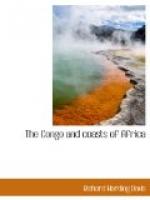Boma really is like a seaport of one of the Central American republics. It has a temporary sufficient-to-the-day-for-to-morrow-we-die air. It looks like a military post that at any moment might be abandoned. To remove this impression the State has certain exhibits which seem to point to a stable and good government. There is a well-conducted hospital and clean, well-built barracks; for the amusement of the black soldiers even a theatre, and for the higher officials attractive bungalows, a bandstand, where twice a week a negro band plays by ear, and plays exceedingly well. There is even a lawn-tennis court, where the infrequent visitor to the Congo is welcomed, and, by the courteous Mr. Vandamme, who plays tennis as well as he does every thing else, entertained. Boma is the shop window of Leopold’s big store. The good features of Boma are like those attractive articles one sometimes sees in a shop window, but which in the shop one fails to find—at least, I did not find them in the shop. Outside of Boma I looked in vain for a school conducted by the State, like the one at Boma, such as those the United States Government gave by the hundred to the Philippines. I found not one. And I looked for such a hospital as the one I saw at Boma, such as our government has placed for its employes along, and at both ends of, the Isthmus of Panama, and, except for the one at Leopoldville, I saw none.
In spite of the fact that Boma is a “European watering-place,” all the servants of the State with whom I talked wanted to get away from it, especially those who already had served in the interior. To appreciate what Boma lacks one has only to visit the neighboring seaports on the same coast; the English towns of Sierra Leone and Calabar, the French town of Libreville in the French Congo, the German seaport Duala in the Cameroons, but especially Calabar in Southern Nigeria. In actual existence the new Calabar is eight years younger than Boma, and in its municipal government, its street-making, cleaning, and lighting, wharfs, barracks, prisons, hospitals, it is a hundred years in advance. Boma is not a capital; it is the distributing factory for a huge trading concern, and a particularly selfish one. There is, as I have said, only one wharf, and at that wharf, without paying the State, only State boats may discharge cargo, so the English, Dutch, and German boats are forced to “tie up” along the river front. There the grass is eight feet high and breeds mosquitoes and malaria, and conceals the wary crocodile. At night, from the deck of the steamer, all one can see of this capital is a fringe of this high grass in the light from the air ports, and on shore three gas-lamps. No cafes are open, no sailors carouse, no lighted window suggests that some one is giving a dinner, that some one is playing bridge. Darkness, gloom, silence mark this “European watering-place.”
“You ask me,” demanded a Belgian lieutenant one night as we stood together by the rail, “whether I like better the bush, where there is no white man in a hundred miles, or to be stationed at Boma?”




